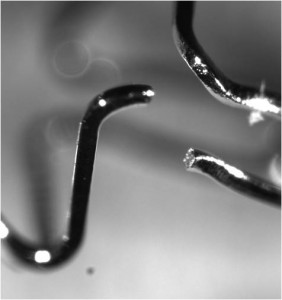 We were curious about how mean stress would affect the fatigue life of the gStent-BE standardized test stent so we designed an experiment to explore. We followed the original axial fatigue test protocol but added an initial deformation to the stent prior to testing. The idea was to introduce different amounts of mean stress by plastically deforming the stent by stretching it, illustrated in the figure on the left.
We were curious about how mean stress would affect the fatigue life of the gStent-BE standardized test stent so we designed an experiment to explore. We followed the original axial fatigue test protocol but added an initial deformation to the stent prior to testing. The idea was to introduce different amounts of mean stress by plastically deforming the stent by stretching it, illustrated in the figure on the left.
Sure enough, the fracture location changed and was consistent. More good news for the gStent-BE standardized test stent! We only had enough samples to just begin converging results for two mean stress conditions—one based on a 6mm stretch and the other a 9mm stretch. (It wouldn’t have been possible to the testing without the use of the D-optimal method). There was a statistically significant difference between the two sets of data, with the greater stretch and higher mean stress having a lower fracture threshold.
The photograph below is a typical fracture of the gStent-BE under non-zero mean stress conditions.

